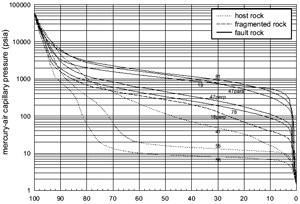| |||||||
|
|
|||||||
|
|
|||||||
| Capillary Pressure of Sheared Joint-based Faults in Sandstone | |||||||
|
Flodin (2003) and Flodin et al. (2005) reported high-pressure mercury-injection analyses of host rocks, fragmented rocks, and fault rocks from three stations at a strike-slip fault in sandstone at Valley of Fire State Park, Nevada. The term entry pressure identifies the pressure at which the mercury accesses the largest pore radius size and is signified by the first slope break in the mercury-air capillary pressure curve at low capillary pressure. The term breakthrough pressure identifies the lowest pressure at which a through-going fluid pathway forms in the sample. Figure 1 shows the result by Flodin (2003) and Flodin et al. (2005) as a function of cumulative percent intruded mercury up to a maximum applied pressure of 60,000 psi. The curves for the host rock are the most complex, and are different from each other and from the curves representing the deformed samples. In general, host rock samples display the lowest entry pressures. Following the initial slope break, one host rock sample adjacent to a fault shows an additional slope break around 20% intruded mercury, and a gradual steepening of the slope after that point. Curves for the two undamaged host rocks have shallow slopes for the first 60% intruded mercury. Beyond this point, the curves record sharply increasing pressures and two slope breaks for each sample between 65 and 90% intruded mercury. Fault rock sample curves possess similar forms and show the highest initial entry pressures. These curves are characterized by a sharp increase in mercury-air capillary pressure followed by a shallow, but steady pressure increase. The fragmented rock sample shows a somewhat lower entry pressure followed by two slope changes around 10 and 30% intruded mercury.
These results show that fault rocks derived from nearly pure quartz sandstone are capable of sealing small to moderate hydrocarbon columns if the fault rock with high breakthrough pressure is present as a continuous interface across the fault surface. For typical fluid properties, calculated hydrocarbon column heights for fault rocks range between 10 and 69 m of gas, and 17 and 120 m of oil. | |||||||
| Reference: |
|||||||
| Flodin, E.A., 2003 Flodin, E.A., Gerdes, M., Aydin, A., Wiggins, W.D., 2005 |
|||||||
|
Readme | About Us | Acknowledgement | How to Cite | Terms of Use | Ⓒ Rock Fracture Knowledgebase |
|||||||
